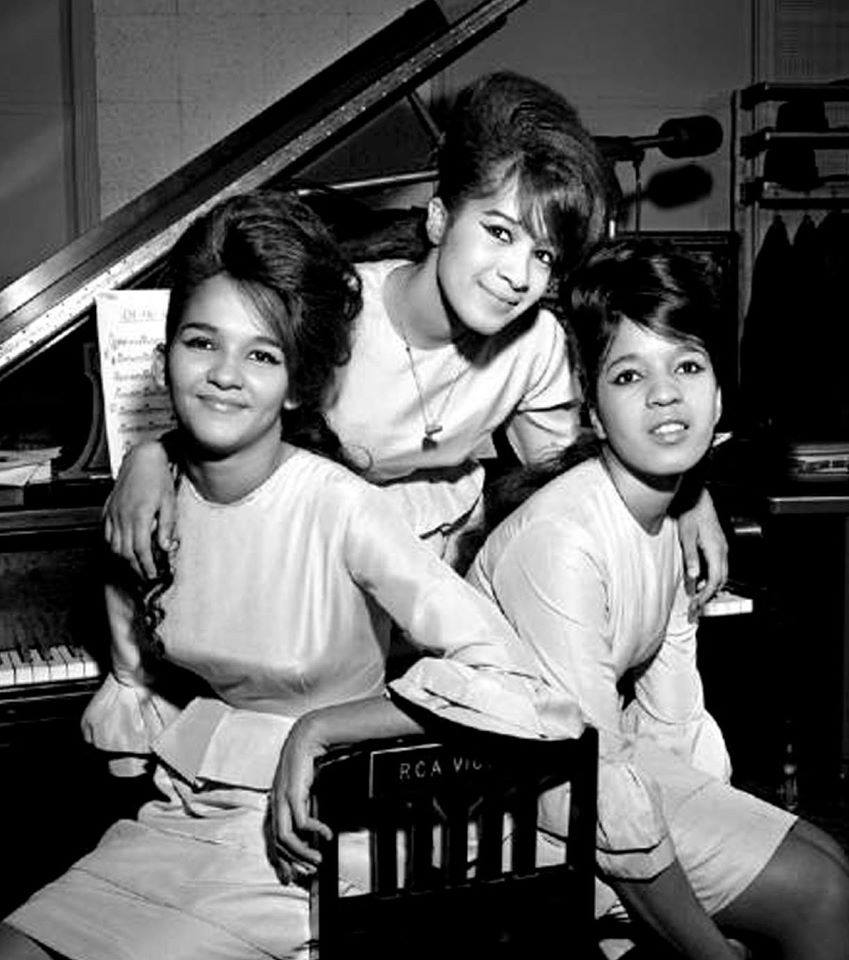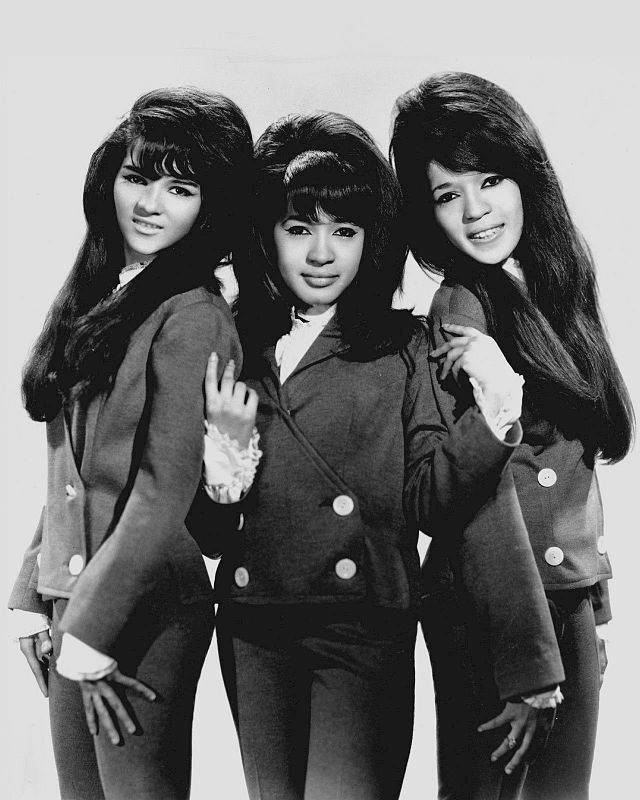BIOGRAPHICAL DETAILS
Description: Vocal Group, USA
Known For: Hit – “(The Best Part Of) Breakin
Instruments: Vocals
Music Styles: Rock
Location: United States of America
CONTACT DETAILS
Web Site: ‘The Ronettes’ Vocal Group Hall of Fame Page
Other Links: See below:
YOUTUBE VIDEO
BIOGRAPHICAL PROFILE
The Ronettes
The Ronettes were an American 1960s girl group from New York City. One of the most popular groups from that period, they placed more than eight songs on the Billboard Hot 100, five of which became top forty hits.
The trio from Spanish Harlem, New York consisted of lead singer Veronica Bennett (later known as Ronnie Spector), her older sister Estelle Bennett, and their cousin Nedra Talley. The girls had sung together since they were teenagers, when they were known as “The Darling Sisters.” Signed first by Colpix Records in 1961, they moved to Spector’s Philles Records in March 1963, and changed their name to “the Ronettes.”
Some of the Ronettes’ most famous songs include, “Be My Baby”, “Baby, I Love You”, “(The Best Part Of) Breakin’ Up”, and “Walking in the Rain,” all of which charted on the Billboard Hot 100. “Walking in the Rain” won a Grammy Award in 1965, and “Be My Baby” was inducted into the Grammy Hall of Fame in 1999.
In the late 1964, the group released their only studio album, Presenting the Fabulous Ronettes Featuring Veronica, which entered the Billboard charts at #96. Rolling Stone ranked it number 422 on its list of The 500 Greatest Albums of All Time. In 2007, the Ronettes were inducted into the Rock and Roll Hall of Fame, and into the Vocal Group Hall of Fame in 2004. The Ronettes were the only girl group that toured with the Beatles.
The Ronettes began as a family act where the girls grew up in Washington Heights, Manhattan. According to Nedra Talley, the girls started singing during their childhood visits to their grandmother’s home. “Estelle and Veronica are sisters,” she said in a later interview. “I’m their cousin. Our mothers are sisters. We came out of a family that, on Saturday nights, home for us was at our grandmother’s, entertaining each other.”
The Bennetts’ mother was African-American and Cherokee; their father was Irish-American. Their cousin, Nedra Talley, is African-American and Puerto Rican.
“By the time I was eight, I was already working up whole numbers for our family’s little weekend shows,” Ronnie Spector later recalled. “Then Estelle would get up onstage and do a song, or she’d join Nedra or my cousin Elaine and me in a number we’d worked out in three-part harmony.”
Furthering their interest in show business, Estelle was enrolled at Startime, a popular dancing school in the 1950s, while Ronnie became fascinated with Frankie Lymon and the Teenagers.
In 1957, Ronnie formed the group which would later become known as the Ronettes. Composed of Ronnie, her sister Estelle, and their cousins Nedra, Diane, and Elaine, the five girls learned how to perfect their harmonies first at their grandmother’s house, and they became proficient in songs such as “Goodnight Sweetheart” and “Red Red Robin”. Emulating Frankie Lymon and the Teenagers, the girls added their male cousin Ira to the group, and were signed up for a Wednesday-night amateur show at the Apollo Theatre by a friend of Ronnie and Estelle’s mother. The show started out as a disaster; when the house band started playing Frankie Lymon’s “Why Do Fools Fall in Love,” Ira didn’t sing a word, so Ronnie took over. “I strutted out across the stage, singing as loud as I could,” Ronnie later recalled. “When I finally heard a few hands of scattered applause, I sang even louder. That brought a little more applause, which was all I needed.”
After their night at the Apollo, Ira, Elaine, and Diane left the group. Renaming themselves Ronnie and the Relatives, Ronnie, Estelle, and Nedra began taking singing lessons two afternoons a week. Appearing at local bar mitzvahs and sock hops, they met Phil Halikus, who introduced them to Colpix Records producer Stu Phillips.
According to Ronnie, Phillips played the piano while the girls auditioned for him, singing “What’s So Sweet About Sweet Sixteen.” Successful, they were brought into the studio in June 1961 and recorded four tracks: “I Want a Boy,” “What’s So Sweet About Sweet Sixteen,” “I’m Gonna Quit While I’m Ahead,” “and “My Guiding Angel.” Colpix released “I Want a Boy” in August 1961 and “I’m Gonna Quit While I’m Ahead” in January 1962, the first singles credited to Ronnie and the Relatives.
While both singles failed to chart on the Billboard Top 100, fate intervened in advancing the group’s success. A fortuitous case of mistaken identity led to Ronnie and the Relatives making their debut – as dancers rather than a singing act – at New York City’s hip Peppermint Lounge in 1961. It was the height of the Twist craze and the underage Nedra and Ronnie needed to disguise themselves to get in. The girls’ mothers showed them how to put on make-up and fix their hair to look at least twenty-three. When they arrived outside the club its manager mistook Ronnie, Estelle, and Nedra for the trio supposed to dance behind house band Joey Dee and the Starliters. They followed him in, were brought up on stage, and performed in their place. During the show, Starliter David Brigati even handed the mike over to Ronnie when she started to sing Ray Charles’s “What’d I Say.”
Soon afterward, Ronnie and the Relatives became a permanent act at the Peppermint Lounge, earning $10 a night per girl to dance the Twist and usually sing a song at some point in the show. Ronnie and the Relatives became The Ronettes.
Later that year they were flown down to Miami to open up a Florida branch of the Peppermint Lounge. Colpix issued the first two singles credited to the Ronettes, “Silhouettes,” and a re-issue of “I’m Gonna Quit While I’m Ahead”, on its May label in April and June 1962, respectively. Both singles failed to chart.
After their performance at the Miami gala, radio host Murray the K came backstage and introduced himself to the act. He wanted the girls to begin appearing at his shows at the Brooklyn Fox in New York. They agreed, taking the Fox stage in 1962 and completing a transition from Murray the K’s “Dancing Girls,” to back-up singing for other acts, to performing as the Ronettes before year’s end.
It was during this time the girls evolved their iconic look, wearing ever more exaggerated eye make-up and teasing their hair to impossible proportions. “We’d look pretty wild by the time we got out onstage,” Ronnie later recalled, “and the kids loved it.”
Colpix’s May label issued one final single by the Ronettes in March 1963. When “Good Girls” failed to chart, the girls decided it was time to look elsewhere for studio work.
Phil Spector and Philles Records (1963–1966)
In early 1963, fed up with Colpix Records and the group’s lack of success, Estelle placed a phone call to producer Phil Spector, telling him of the Ronettes, and how they would like to audition for him. Spector agreed, and met the girls soon after at Mira Sound Studios in New York City. Later, Spector told Ronnie that he had seen them at the Brooklyn Fox several times, and was impressed with their performances. At the audition, Spector sat at a piano while the group began singing “Why Do Fools Fall in Love” when he suddenly jumped up from his seat and shouted “That’s it! That’s it! That’s the voice I’ve been looking for!”
After their successful audition, Spector decided to sign the group. Originally, he wanted to sign Ronnie as a solo act, until her mother told him either he signed the Ronettes as a group or it was no deal. He agreed to sign the group, and instructed Ronnie’s mother to inform Colpix Records that the girls had “given up” on show business, in order for the studio to let them out of their contract. By March 1963, the group was officially signed to Spector’s Philles Records.
The first song the Ronettes rehearsed and recorded with Phil Spector was a song by Spector, Jeff Barry, and Ellie Greenwich called “Why Don’t They Let Us Fall in Love”. They were brought out to California to make the record, but, once it was complete, Spector refused to release it.[24] They recorded more songs for Spector, including covers of “The Twist,” “The Wah Watusi,” (lead vocals by Nedra), “Mashed Potato Time,” and “Hot Pastrami.” These four songs were released, but were credited to The Crystals on their 1963 Philles LP The Crystals Sing The Greatest Hits, Volume 1.
Opening for The Beatles
After “Is This What I Get for Loving You?” was released in June 1965, over a year passed before the group’s next single was released. “I Can Hear Music”, written by Phil Spector, Jeff Barry, and Ellie Greenwich, was issued in October 1966, barely making it into the Billboard 100 by peaking at number 100 for exactly one week before it fell off the charts. The song was covered by The Beach Boys in 1969 with much greater success. The Ronettes 1966 original version of the song was produced by Jeff Barry.
From the start of their career, the Ronettes were always a popular live act. After “Be My Baby”, the group became headliners at several Murray the K Holiday Shows in NYC, and did package tours in the US and England. By late 1965, even without a recent hit, the group continued to make appearances at popular night clubs, on television shows, grace the covers of music magazines and be featured on The Big TNT Show, which was produced by Phil Spector as a concert that was filmed and released as a TV movie.
In August, 1966, the Ronettes teamed up with The Beatles for a fourteen-city tour across America. Phil Spector became so enraged when Ronnie expressed a desire to accompany Estelle and Nedra on the tour, that she was forced to remain in California with him while the girls’ cousin Elaine, who had previously been in the group, filled her slot on the tour, while Nedra assumed the lead vocals on stage. A picture published in the November 1966 issue of Ebony Magazine showed Nedra Talley singing lead, while Estelle and Elaine stood behind her singing harmony.
The group’s initial break-up
After their tour with the Beatles ended and “I Can Hear Music” failed to make an impact, the Ronettes left for a tour in Germany in early 1967, after which they agreed to break up and go their separate ways. Soon afterward Nedra Talley married her boyfriend Scott Ross, Ronnie married Phil Spector, and Estelle Bennett settled down with Joe Dong, a long-time boyfriend.
According to her accounts, Phil Spector kept Ronnie a near-prisoner in their twenty-three room mansion in California. He brought her into the studio only once during their marriage. During this session, which took place in early 1969 at A&M Records, she recorded “You Came, You Saw, You Conquered!” The song was released in March 1969, failing to make an impact on the radio stations which were now playing the music in the style of Janis Joplin and Grace Slick.
Later in 1969, Ronnie and Estelle were invited into the studio by Jimi Hendrix to record backing vocals on “Earth Blues.” Their work on the song earned the Ronettes a credit on the LP Rainbow Bridge.
1963 “Be My Baby”
1963 “Baby, I Love You”
1964 “(The Best Part Of) Breakin’ Up”
1966 “I Can Hear Music”
Links:
- The Ronettes at DMOZ
- The Ronettes at AllMusic
- ‘The Ronettes’ Vocal Group Hall of Fame Page
- Ronettes’ Profits Limited by 1963 Contract, New York Law Journal, October 21, 2002
- A Sad Song for the Ronettes: Court Reverses Royalty Rights



